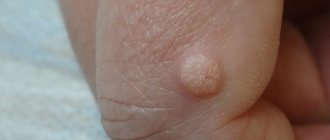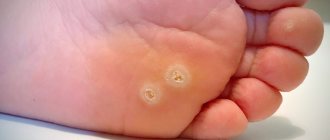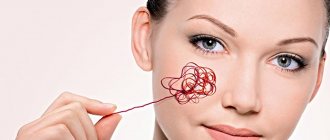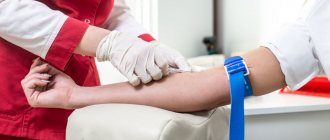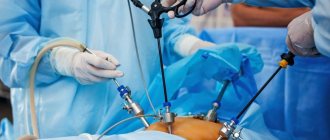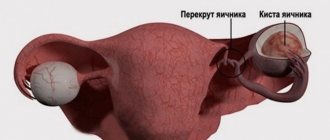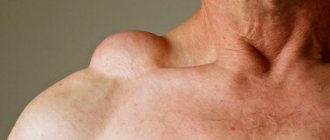Fordyce granules
Fordyce granules: why they occur and how to get rid of them
For some this is an almost unnoticeable trifle, but for others it is a serious cosmetic defect. What are Fordyce granules and can they be treated? What do cosmetologists and dermatologists offer to patients who come to them with such a problem?
WHAT ARE FORDYCE GRANULES
Fordyce granules (or Fordyce disease) are light-colored pimples (sebaceous glands) that can form on the oral mucosa, cheeks, lips, female labia, surface of the male penis, breast nipples, groin area and other places on the body Currently, Fordyce granules are considered normal, but in some cases they can cause severe discomfort. Fordyce granules are also called seborrheic cysts.
According to medical statistics, Fordyce disease affects 35% of women and 60% of men. The granules do not lead to the development of complications, do not cause harm to health, and are not transmitted to a partner during sexual intercourse. Most often, patients with seborrheic cysts seek medical help because of a cosmetic defect, since these neoplasms do not cause any other complications.
FORDYCE GRANULES: REASONS
The reasons for the appearance of Fordyce granules are still unclear. Despite the name "seborrheic cysts", no connection with seborrhea has been found in Fordyce granules. Most often, these neoplasms occur during puberty, when hormonal changes in the body give rise to the appearance of sebaceous gland cysts.
The current prevailing view is that the main cause of Fordyce granules is that in some people the sebaceous glands are located too close to the upper layer of the dermis and epidermis. In some cases, they are located abnormally - on the border of the lips or on the mucous membrane of the mouth.
It is noteworthy that this arrangement of the sebaceous glands is congenital in nature, however, during puberty (13-16 years), under the influence of sex hormones (in particular, male sex hormones), the activity of the sebaceous glands increases. In adolescence, the level of sebum production increases, which leads to the noticeable appearance of sebaceous gland granules.
Doctors identify several factors that contribute to the appearance of granules, including:
- smoking;
- damage to the ducts of the sebaceous glands;
- neglect of hygiene rules;
- hormonal imbalances;
- narrowing of the excretory ducts of the sebaceous glands.
It is noteworthy that Fordyce granules can be present in a person for many years, but after 40 years, seborrheic cysts can disappear on their own.
Fordyce granules
FORDYCE GRANULES ON THE LIPS
Unlike Fordyce granules on other parts of the body, seborrheic cysts on the lips are smaller (diameter does not exceed 2 millimeters) and less convex. They are white or pale yellow in color. For some people, the granules cause itching, but you should not scratch them, as this can lead to infection. In this case, it would be best to consult a doctor so that a specialist can prescribe antipruritic medications.
In addition, do not try to squeeze out the nodules under any circumstances. Firstly, this will not get rid of the rash, but on the other hand, when you try to squeeze out the nodule, a hematoma will form due to minor bleeding. In this case, scars may remain, which in an aesthetic sense is much worse than Fordyce granules.
FORDYCE GRANULES: TYPES
There are two types of Fordyce granules:
- Fox-Fordyce disease
- Pearly penile papules
As for pearly penile papules, this is a variant of the norm . According to medical research, they occur in 30% of young men . They do not cause any harm to health, and are not sexually transmitted and do not cause any complications, so the man and his sexual partners have nothing to worry about.
In medicine, the problem of pearly papules has been poorly studied, and doctors do not have sufficient awareness of this phenomenon. There is no effective treatment for pearlescent papules yet, but it is not required.
The reason for the appearance of pearly papules on the penis is also still unclear. Some experts believe that the whole problem comes down to excessive proliferation of the epithelium of the excretory ducts of the glands of the penis. Other doctors are inclined to believe that the reason for the appearance of pearly papules is fibroplastic proliferation of areas of the epithelium of the glans penis.
As a rule, pearly penile papules appear during puberty, when the level of male sex hormones in the blood increases. It is noteworthy that among peoples who practice circumcision, the incidence of pearly papules is significantly lower than among others. It is believed that this is due to the fact that the increased amount of secretions and smegma with a circumcised penis is more easily released during hygiene measures.
As for Fox-Fordyce disease, it is an analogue of pearly papules, but only in women. The clinical manifestations of Fox-Fordyce disease are the same as those of pearly penile papules. This lesion is localized in the apocrine sweat glands and is to some extent associated with urinary function. It is possible that Fox-Fordyce disease is of endocrine origin.
Localization of granules in Fox-Fordyce disease is on the pubis, axillary fossae, perineum, labia majora, and around the nipples. As a rule, Fox-Fordyce disease is manifested by moderate skin itching, which intensifies during menstruation. Fox-Fordyce disease lasts for years and often goes away on its own after age 40.
DIAGNOSTICS OF FORDYCE GRANULES
When examining a patient, the picture of the rash is quite typical, and only on the basis of examination can the doctor make a diagnosis. However, if there are too many rashes, then there is a danger of confusing them with other diseases. In particular, when conducting diagnostics, it is important to differentiate Fordyce granules from eczema, lichen planus, neurodermatitis and molluscum contagiosum. In this regard, during the examination, the doctor may take a smear or prescribe a biopsy for microscopic examination of the sample taken.
FORDYCE GRANULES: TREATMENT
There are currently no effective treatments for Fordyce granules. It is impossible to completely get rid of such rashes. At the same time, doctors offer their patients some alternative techniques that can slightly improve the cosmetic effect. In particular, patients are offered jojoba oil, as well as laser nodule removal procedures. It is difficult to talk about the effectiveness of these procedures, since the effect is different for different patients (but not high).
It is noted that with regular use of the products it is possible to prevent the appearance of new Fordyce granules. Removing granules using laser, cosmetic surgery or cryotherapy may only be effective for a while, as the granules reappear after some time. Effective methods for the prevention of Fordyce granules have also not yet been developed.
Each organism has its own characteristics and even the most harmless intervention can manifest them. One of these manifestations is Fordyce granules, and patients often find out about them only after the procedure.
Fordyce granules
Anamnesis
The patient came in for lip augmentation. This was her second procedure. The previous one was carried out three months ago by another specialist and, according to the girl, did not lead to the expected result.
Lip augmentation was performed with hyaluronic acid and went without complications.
Complementary therapy
To reduce swelling and prevent the appearance of hematomas, a homeopathic medicine was prescribed, 5 granules 4 times a day, several days before and after the procedure.
Complaints
10 days after the modeling, the patient began to complain of “yellowish dots in the upper lip area.”
Since telephone consultation is not acceptable, the patient was asked to attend an appointment. The girl ignored the advice and decided to go straight to a dermatologist.
Consultation with a dermatologist. Diagnosis
The dermatologist diagnosed an “allergic reaction to the filler” and prescribed treatment in the form of surgical removal of the papules “one at a time.”
It is important to know that an allergic reaction to hyaluronic acid occurs on the first day after administration of the drug.
It appears:
- inflammation
- severe swelling
- redness
- increase in temperature in the injection area and/or the whole body
Diagnosis by an esthetician
In fact, the patient’s complaint is related to the physiological state of her lips. The girl has a skin defect called Fordyce granules. After the filler was injected into the lips, features (granules) that were previously insignificant also increased.
Fordyce granules are painless skin formations, seborrheic cysts, which are small papules with white-yellow contents of a dense consistency.
This skin feature does not cause any harm to health and is only a cosmetic defect.
There is no specific treatment. Therapeutic treatment does not bring the expected result. They offer cryotherapy, electrocoagulation and laser therapy.
There is no prevention, since seborrheic cysts are not considered a disease, but are a variant of the norm.
Source: likar.info, estet-portal.com
Medical scientific and practical journal “Science & Medicine”
Reasons for appearance on the areola
Despite the concept of “seborrheic cyst,” seborrhea does not provoke the appearance of Fordyce formations on the nipple areola. With seborrhea, the components of sebum change, which causes blood clots in the sebaceous duct, and, accordingly, the appearance of similar growths. Fordyce's disease is not characterized by any changes in fatty fluid. Therefore, in this case, the name is more relevant - sebaceous cyst. Unfortunately, doctors have not yet been able to establish a single cause for the occurrence of such neoplasms. Nevertheless, it has been repeatedly noted that this phenomenon occurs mainly during puberty. It is likely that a hormonal imbalance in the body contributes to the disease. Against their background, the sebaceous glands secrete excessive amounts of sebum, which turns into cysts. For the first time, neoplasms can appear between the ages of 12 and 17, when the glands are at their peak of activity. In the future, the number of growths increases regardless of age and lifestyle.
We recommend reading:
- Removing warts with vinegar
- Effective ointments for the treatment of wen
- Vortex cream and its effect on warts
Often, in people with a similar disease, the location of the sebaceous glands is noted much closer to the upper layer of the skin than with normal physiology. Also, patients with this disease experience hyperplasia (narrowing) of the sebaceous ducts, which can be congenital or acquired.
Removal methods and prevention
The removal of Fordyce granules on the papillae is done using some special procedures. The exact method used to perform the operation depends on the individual characteristics of the patient, as well as the degree of tumor growth. The most popular methods are:
- Electrocoagulation is exposure to high frequency current. The method is notable for its comparative painlessness and absence of bleeding. In addition, there are practically no scars left after such an event.
- Cryodestruction or freezing with liquid nitrogen. Removal occurs under the influence of the lowest possible temperature. The tissues of the formation freeze and die. The procedure is quite painful and is performed under local anesthesia.
- Laser excision is a procedure that involves the use of a special laser. It burns the tissues of the formation, completely destroying its structure.
- The surgery is performed under general anesthesia. Since the procedure is quite invasive, it is used only in emergency cases.
None of the above methods of excision can guarantee a long-term effect. Most often, after some time, the granules appear again.
Treatment at home
You can try to remove the growths using traditional medicine. Based on medicinal plants, decoctions, tinctures or ointments should be prepared for topical use. If the granules cause itching and local discomfort, you can use chamomile. To do this, pour 1 tablespoon of the plant’s flowers with a glass of water, put on low heat and wait until it boils. Next, wait until the broth cools down and strain through cheesecloth. Wipe your nipples twice a day. If there is a burning sensation, you can use essential oils that are applied to the surface of the growths.
Although Fordyce granules are a very unpleasant phenomenon, they do not pose any particular danger to humans.
Don't rip them off or try to squeeze them out. When it appears, it is better to consult a doctor who will tell you how to cope with a similar ailment on the chest. The article has been verified by the editors

